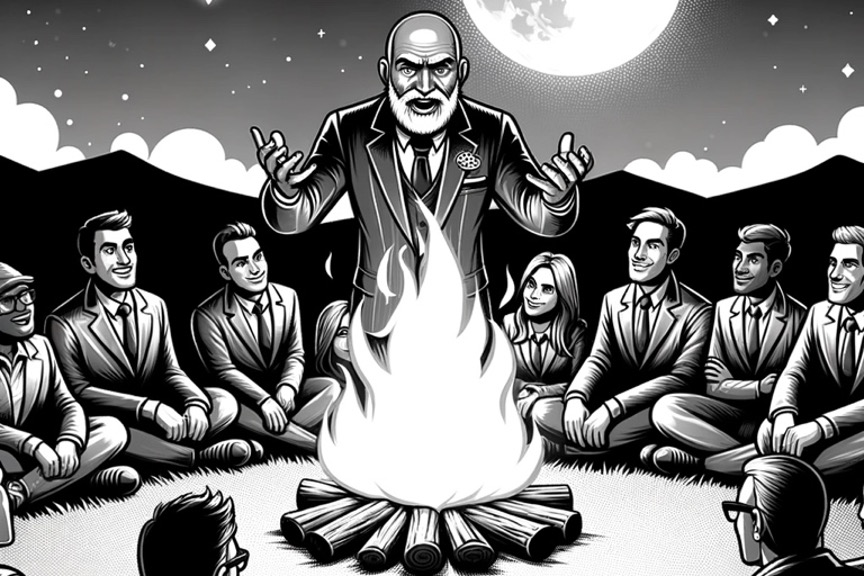Storytelling emerges as a vital tool, not just for communication, but as a fundamental aspect of effective leadership. Sam Palazzolo, Principal Officer at the Javelin Institute, explores the nuanced relationship between storytelling and leadership. He proposes that storytelling transcends the mere act of telling a good story; it is about crafting narratives that resonate, inspire, and compel action. This article delves into the essence of storytelling, its impact on leadership, and the symbiotic relationship between leading and storytelling… Enjoy!
KEY TAKEAWAYS
- Storytelling is a fundamental component of effective leadership, with both disciplines focused on guiding others toward a shared destination or vision.
- The essence of storytelling in leadership lies in the ability to craft narratives that not only engage and resonate on an emotional level but also inspire action and change.
- Effective leadership, similar to storytelling, requires the leader to connect deeply with their audience (or team) to mobilize them towards achieving common goals.
- Leadership extends beyond self-direction; it’s about inspiring others to follow and commit to the vision or journey the leader has outlined.
- The true measure of a leader’s effectiveness is not solely based on their vision or decision-making but on their ability to garner followers and inspire them to take action.
- Storytelling in leadership serves as a bridge between the leader’s vision and the followers’ actions, crafting a compelling narrative that motivates and unifies the team.
- The impact of storytelling in leadership is evaluated by the actions they inspire and the followers they attract, underscoring the importance of narratives that resonate and lead to collective movement towards a shared purpose.
Introduction to Storytelling and Leadership
Storytelling and leadership, at first glance, may seem like distinct disciplines. However, at their core, both are about guiding others to a destination—whether it’s the conclusion of a narrative or a vision for the future. From my experience in executive education and coaching, effective leadership, much like storytelling, hinges not just on the actions of the leader but on the engagement and following they inspire.
The Essence of Storytelling in Leadership
As we peel back the layers of traditional leadership paradigms, we uncover the essential role that storytelling plays in truly transformational leadership. This section, “The Essence of Storytelling in Leadership,” invites readers to explore the profound ways in which the art of storytelling underpins the core of influential leadership. Here, we will dissect the elements that make storytelling a powerful tool for connection, understanding, and inspiration. It’s about the stories leaders choose to tell, the authentic self they bring into these narratives, and the emotional resonance that forges deeper bonds and drives collective action.
The Art of Telling a Good Story
A compelling story captivates the audience, holds their attention, and evokes emotions. Similarly, effective leadership captures the imagination of followers, engages their interests, and resonates on an emotional level. The artistry in storytelling lies not only in the plot or the characters but in the storyteller’s ability to connect with the audience on a profound level. In leadership, this translates to the leader’s capacity to empathize, engage, and elevate their team towards a shared vision.
The Impact: How Stories Resonate and Inspire Action
The power of a story is not merely in its telling but in its ability to inspire action and effect change. Stories that resonate lead to transformation within the listener, compelling them to act. I equate this to the essence of leadership: the true measure of a leader is not in the eloquence of their speech but in their ability to lead others to action. A leader’s success is defined by their impact—how their vision and direction mobilize people towards achieving common goals.
Leadership through Storytelling
Moving beyond the foundational principles of storytelling, we transition to the tangible applications within the realms of leadership in our next section, “Leadership through Storytelling.” This discussion will shift focus from theory to practice, illustrating how effective leaders harness the power of storytelling to catalyze change, build communities, and guide their followers toward a shared vision. Within these paragraphs lies an exploration of storytelling’s role in amplifying a leader’s influence, transcending mere rhetoric, and becoming a living testament to their vision and values.
Leading Beyond the Self
I challenge leaders to look beyond the mirror of self-leadership to the broader horizon of leading others. I’ve often said that true leadership is tested not when you’re leading yourself, but when you inspire others to follow. The act of storytelling in leadership serves as a bridge, connecting the leader’s vision to the aspirations and actions of their followers. It’s about crafting a narrative that others see themselves in, a story so compelling that it moves them to join you on the journey.
The Litmus Test of Leadership
I often challenge those that are leaders with the question, “Are you a leader if no one is following you?” In doing so, I attempt to underscore a fundamental truth about leadership. The litmus test of a leader’s effectiveness is the presence of followers—individuals who, convinced by the leader’s vision and inspired by their conviction, choose to embark on the journey. This reflects the ultimate power of storytelling: not just to tell a story, but to invite others into the story, making it their own and moving them to action.
Summary
I share my insights into storytelling and leadership to help illuminate the intrinsic connection between the two. Storytelling, in its most impactful form, goes beyond mere narration; it’s an essential leadership skill that involves engaging an audience, resonating on a deep emotional level, and inspiring action. Leaders must see themselves not just as visionaries or decision-makers but as storytellers who craft compelling narratives that mobilize and unify their teams towards a shared purpose. In the end, the effectiveness of storytelling in leadership is measured not by the eloquence of the narrative or the charisma of the leader, but by the action it inspires and the followers it garners.
Sam Palazzolo, Principal Officer @ The Javelin Institute
